An Overview of Germanic Grisailles through the Stained-Glass Collection at Pena Palace
Abstract
1. Introduction
1.1. Case Study: The Collection of Ferdinand II
1.2. Main Objectives
2. Materials and Methods
2.1. Panels
2.2. Analysis
2.2.1. µ-EDXRF
2.2.2. µ-PIXE
3. Results
4. Discussion
4.1. Cu-Fe Pigment Grisailles (14th to 18th Century Panels)
4.1.1. 14th Century: A Singular Case
4.1.2. 15th/16th Century: Three for One
4.1.3. 16th/17th Century: A More Complex Interpretation
4.1.4. 18th Century: A Homogeneous Group
4.2. 19th Century Panels: Grisailles vs. Other Black-Paint Materials
4.2.1. Group 1: Historische Memorabilien Panels
4.2.2. Group 2: The Two Cherubim Angels
4.2.3. Group 3: Uncertain Attributions
4.2.4. Group 4: Ungrouped Items
4.3. Literature Comparison
5. Conclusions
Author Contributions
Funding
Institutional Review Board Statement
Informed Consent Statement
Data Availability Statement
Acknowledgments
Conflicts of Interest
Appendix A. Grisaille Composition
| Panel (Grisaille) | Info | SiO2 | CaO | TiO2 | Cr2O3 | MnO | Fe2O3 | CoO | ||
|---|---|---|---|---|---|---|---|---|---|---|
| PNP2874 | Agnes of Bavaria | 8.8–13.7 | 15.5–24.0 | 0.06–0.10 | n.d. | 0.02–0.04 | 0.78–0.94 | traces | ||
| PNP2809 | St. Gregory | Type (a) | 57.0–59.3 | 5.4–10.3 | 0.16–0.26 | n.d. | 0.49–0.89 | 1.9–4.0 | traces | |
| Type (b) | 14.3–30.1 | 5.4–7.0 | 0.11–0.21 | n.d. | 0.61–2.07 | 1.6–2.2 | n.d. | |||
| PNP2821 | St. Ambrose | Type (a) | 12–30 | 8–12 | 0.2 | 0.6 | n.d. | |||
| Type (b) | 45.7–51.8 | 7.1–15.9 | 0.10–0.13 | n.d. | 0.13–0.47 | 0.84–0.96 | traces | |||
| PNP2822 | Virgin of Apocalypse | Type (a) | 15.2 | 14.0 | 0.09 | n.d. | 0.48 | 1.39 | traces | |
| Type (b) | 41.5–43.1 | 10.0–10.2 | 0.16 | n.d. | 0.77–1.20 | 1.47–1.73 | traces | |||
| PNP2785 | Virgin with Child | 6.2–14.6 | 12.8–25.5 | 0.04–0.12 | n.d. | 0.03–0.28 | 7.7–15.6 | traces | ||
| PNP2870 | Ascension of the Virgin | 10.9–46.5 | 18.1–25.9 | 0.05 | n.d. | 0.55–1.21 | 7.1–19.0 | 0.31–0.90 | ||
| PNP2931 | Baptism of Christ | 25.0–27.3 | 12.4–21.6 | 0.16–0.23 | n.d. | 0.35–0.49 | 2.02–2.57 | traces | ||
| PNP2883 | Bierscheiben | Type (a) | 58.2–63.7 | 16.3–20.2 | 0.30–0.40 | n.d. | 0.72–0.94 | 3.2–3.8 | n.d. | |
| Type (b) | 18.6–38.9 | 4.8–12.1 | 0.06–0.10 | n.d. | 0.23–0.25 | 4.4–5.0 | n.d. | |||
| PNP2884 | Bierscheiben | PIXE | 9.9–16.6 | 7.1–8.3 | 0.08–0.11 | 0.01 | 0.14–0.23 | 1.05–1.18 | traces | |
| EDXRF | 24.3–29.9 | 3.9–11.7 | 0.02–0.10 | n.d. | 0.11–0.51 | 0.94–2.41 | traces | |||
| PNP2886 | Bierscheiben | PIXE | 38.4–43.1 | 4.5–10.5 | 0.07–0.11 | n.d. | 0.23–0.33 | 1.03–1.15 | n.d. | |
| PNP2888 | Bierscheiben | PIXE | 20.2–21.3 | 3.4–4.6 | 0.08 | n.d. | 0.07–0.11 | 1.73–1.77 | traces | |
| continuation | Info | NiO | CuO | ZnO | SrO | As2O3 | BaO | PbO | Fe/(Cu + Fe) | |
| PNP2874 | Agnes of Bavaria | 0.12–0.17 | 29.1–34.2 | 0.12–0.13 | n.d. | n.d. | n.d. | 28.0–36.8 | 3/100 | |
| PNP2809 | St. Gregory | Type (a) | 0.04–0.07 | 0.37–0.49 | 0.12–0.16 | 0.06 | n.d. | 0.16–0.24 | 18.6–23.3 | 86/100 |
| Type (b) | 0.02–0.10 | 2.0–12.7 | 0.26–0.29 | 0.09–0.11 | n.d. | 0.11–0.45 | 20.2–40.1 | 34/100 | ||
| PNP2821 | St. Ambrose | (a) | 10–18 | 23–30 | 4/100 | |||||
| (b) | 0.06–0.08 | 0.58–1.10 | 0.07–0.07 | 0.03–0.04 | n.d. | 0.08–0.14 | 21.7–33.4 | 51/100 | ||
| PNP2822 | Virgin of Apocalypse | (a) | 0.08 | 8.7 | 0.42 | 0.12 | n.d. | 0.14 | 49.9 | 14/100 |
| (b) | 0.05–0.08 | 0.75–1.23 | 0.25–0.29 | 0.11–0.13 | n.d. | 0.18–0.25 | 31.5–32.5 | 62/100 | ||
| PNP2785 | Virgin with Child | 0.09–0.38 | 18.2–30.2 | 0.15–0.21 | 0–0.07 | n.d. | 0.01–0.10 | 25.0–33.3 | 31/100 | |
| PNP2870 | Ascension of the Virgin | 0.35–1.10 | 0.25–0.58 | 0.03–0.20 | n.d. | n.d. | 0.11–0.19 | 9.4–36.6 | 100/100 | |
| PNP2931 | Baptism of Christ | 0.10–0.13 | 21.0–22.3 | 1.91–2.56 | 0.09–0.10 | n.d. | n.d. | 16.3–25.5 | 10/100 | |
| PNP2883 | Bierscheiben | Type (a) | 0.02–0.09 | 1.59–1.83 | 0.25–0.34 | 0.05–0.07 | n.d. | 0.19–0.25 | 8.4–9.8 | 67/100 |
| Type (b) | 0.16 | 7.0–9.0 | 0.51–1.13 | 0.04–0.05 | n.d. | 0.03–0.06 | 37.7–51.2 | 36/100 | ||
| PNP2884 | Bierscheiben | PIXE | 0.03 | 18.9–20.3 | 0.23–0.34 | 0.12–0.15 | traces | 0.05 | 41.1–46.0 | 5/100 |
| EDXRF | 0.21–0.22 | 15.8–21.9 | 0.24–0.25 | 0.04–0.11 | b.d.l. | 0.05–0.10 | 32.2–43.5 | 9/100 | ||
| PNP2886 | Bierscheiben | PIXE | 0.02–0.03 | 11.2–16.9 | 0.16–0.20 | 0.05–0.08 | traces | 0.05–0.09 | 23.8–32–1 | 8/100 |
| PNP2888 | Bierscheiben | PIXE | 0.02–0.03 | 11.8–12.3 | 0.13 | 0.04–0.08 | n.d. | 0.02–0.03 | 45.7–47.1 | 13/100 |
| Panel (Grisaille) | Info | SiO2 | CaO | TiO2 | Cr2O3 | MnO | Fe2O3 | CoO | NiO | |
|---|---|---|---|---|---|---|---|---|---|---|
| PNP2601 | Bierscheiben | 29.9–48.3 | 2.3–7.8 | 0.13–0.25 | ∼0.1 | 0.51.0.57 | 0.99–1.99 | 6.5–8.3 | 1.5–2.1 | |
| PNP2520 | King Henry I | 27.5–34.0 | 7.0–9.2 | 0.06–0.07 | 1.2–1.4 | 0.17–0.19 | 11.1–13.3 | 4.7–4.8 | 5.4–5.6 | |
| PNP2521 | The Rütlischwur | 28.2–43.4 | 2.8–8.0 | 0.03–0.08 | 1.2–1.9 | 0.13–0.18 | 11.5–14.5 | 4.2–6.0 | 4.7–6.9 | |
| PNP2524 | Theoderic the Great | 10.6–12.9 | 1.5–19.0 | 0.04–0.15 | 1.1–1.3 | 0.10–0.11 | 12.2–13.6 | 4.8–5.7 | 5.3–6.2 | |
| PNP2562 | Angels?/Querubins? | 26.4–41.7 | 6.1–9.2 | 0.18–0.27 | 3.1–3.5 | 0.09–0.11 | 5.6–6.2 | traces | 0.08–0.11 | |
| PNP2563 | Angels?/Querubins? | 4.0–10–6 | 4.5–11.8 | 0.18–0.22 | n.d. | 0.17–0.28 | 2.1–2.4 | n.d. | 0.31–0.38 | |
| PNP2872 | Fragment from Chapel | 30.1–36.3 | 2.0–2.7 | 0.05–0.07 | 0.5–1.5 | 2.15–3.25 | 3.3–9.8 | 1.2–1.7 | 0.96–1.70 | |
| PNP2908 | Constantine the Great | 17.4–28.5 | 4.4–11.1 | 0.06–0.12 | traces | 1.32–1.84 | 2.3–7.0 | 0.1–0.5 | 0.05–0.41 | |
| PNP2930 | Coat of Arms | 8.2–15.6 | 2.2–2.7 | 0.07–0.11 | 0.3–0.7 | 0.24–0.32 | 1.4–2.6 | 4.7–5.1 | 1.29–1.34 | |
| PNP2932 | Resurrection of Christ | 27.0–29.1 | 6.9–8.4 | 0.06–0.09 | n.d. | 0.20–0.28 | 5.8–10.1 | traces | 0.26–0.27 | |
| PNP2933 | Birth of Christ | 7.6–30.9 | 7.8–10.4 | 0.05–0.16 | n.d. | 1.5–3.8 | 3.2–7.0 | 0.21–0.62 | 0.24–0.49 | |
| Continuation | Info | CuO | ZnO | SrO | As2O3 | BaO | PbO | Colourants | ||
| PNP2601 | Bierscheiben | 8.5–10.9 | 0.43–0.87 | n.d. | 2.2–2.7 | n.d. | 17.6–37.1 | Cu, Co | ||
| PNP2520 | King Henry I | 0.04–0.07 | 3.9–6.5 | n.d. | traces | n.d. | 25.8–30.1 | Fe, Co, Cr | ||
| PNP2521 | The Rütlischwur | 0.04–0.23 | 2.7–4.3 | n.d. | traces | n.d. | 19.4–32.1 | Fe, Co, Cr | ||
| PNP2524 | Theoderic the Great | 0.03–0.07 | 6.5–8.6 | n.d. | traces | n.d. | 30.3–42.1 | Fe, Co, Cr | ||
| PNP2562 | Angels?/Querubins? | 0.03–0.05 | 4.9–8.6 | n.d. | 2.6–2.9 | 0.17–0.33 | 25.6–40.1 | Fe, Cr | ||
| PNP2563 | Angels?/Querubins? | 31.3–33.9 | 7.5–10.5 | 0.09–0.11 | n.d. | n.d. | 31.7–34.5 | Cu, Fe | ||
| PNP2872 | Fragment from Chapel | 1.8–1.9 | 1.9–2.0 | n.d. | 1.9 | n.d. | 37.5–38.0 | Fe, Mn, Cu, Co | ||
| PNP2908 | Constantine the Great | 0.26–0.41 | 1.2–5.4 | n.d. | n.d. | 0.18–0.47 | 42.1–61.0 | Fe, Mn | ||
| PNP2930 | Coat of Arms | 5.6–6.9 | 1.5–2.4 | n.d. | n.d. | 0.08–0.22 | 57.7–65.6 | Cu, Co, Fe | ||
| PNP2932 | Resurrection of Christ | 21.3–22.2 | 0.20–0.26 | 0.04–0.05 | n.d. | 0.10–0.13 | 25.9–29.6 | Cu | ||
| PNP2933 | Birth of Christ | 0.42–0.91 | 1.9–18.0 | 0–0.01 | n.d. | 0.42–0.67 | 32.5–58.7 | Fe | ||
Appendix B. Support Glass Composition
| Panel (Glass) | Analysis | SiO2 | Al2O3 | P2O5 | CaO | K2O | MnO | Fe2O3 | Na2O * | MgO * | Classification | |
|---|---|---|---|---|---|---|---|---|---|---|---|---|
| PNP2874 | Agnes of Bavaria | EDXRF | 49.3 | <1.8 | 0.9 | 17.4 | 21.3 | 0.96 | 0.38 | 8.0 | K-rich | |
| PNP2821 | St. Gregory | EXDRF | 57.2 | 2.8 | 1.6 | 23.0 | 4.7 | 1.29 | 0.49 | 7.6 | HLLA | |
| PNP2809 | St Ambrose | EXDRF | 55.7 | 2.7 | 2.6 | 21.6 | 4.7 | 1.25 | 0.49 | 7.1 | HLLA | |
| PNP2822 | Virgin of the Apocalypse | EXDRF | 56.5 | 2.1 | 0.3 | 22.7 | 4.8 | 1.30 | 0.51 | 7.7 | HLLA | |
| PNP2785 | Virgin with Child | EDXRF | 54.4 | <2.0 | 6.5 | 24.2 | 4.9 | 1.41 | 0.52 | 6.4 | HLLA | |
| PNP2870 | Ascension of the Virgin | EDXRF | 72.7 | 2.8 | 0.6 | 13.0 | 1.8 | 0.32 | 0.55 | 7.6 | Na-Ca | |
| PIXE | 75.5 | 1.7 | 0.2 | 7.9 | 3.9 | 0.11 | 0.34 | 7.9 | 0.24 | Na-Ca | ||
| PNP2931 | Baptism of Christ | EDXRF | 68.2 | <2.5 | 2.7 | 19.1 | 3.5 | 0.44 | 0.50 | b.q.l. | HLLA | |
| PNP2932 | Resurrection of Christ | EDXRF | 86.0 | 2.1 | <0.2 | 9.9 | 0.7 | 0.04 | 0.29 | b.q.l. | HLLA? | |
| PNP2933 | Birth of Christ | EDXRF | 67.3 | <1.4 | <0.1 | 5.3 | 14.2 | 0.05 | 0.13 | 10.8 | Mixed alkali | |
| PNP2883 | Bierscheiben | EDXRF | – | – | – | – | – | – | – | – | – | HLLA? |
| PNP2884 | Bierscheiben | PIXE | 60.0 | 4.0 | 2.3 | 20.8 | 1.6 | 0.61 | 1.4 | 4.7 | 3.2 | HLLA |
| PNP2886 | Bierscheiben | PIXE | 61.6 | 3.7 | 2.1 | 20.0 | 1.4 | 0.55 | 1.3 | 5.2 | 2.9 | HLLA |
| PNP2888 | Bierscheiben | PIXE | 61.7 | 4.0 | 1.9 | 19.2 | 2.4 | 0.81 | 1.2 | 4.9 | 2.7 | HLLA |
| PNP2601 | Bierscheiben | EDXRF | 67.0 | <2.5 | <1.0 | 8.3 | 0.3 | 0.01 | 0.1 | 21.7 | Na-Ca | |
| PNP2520 | King Henry I | EDXRF | 74.5 | <2.9 | <1.5 | 11.5 | 3.2 | 0.12 | 0.37 | 13.7 | Na-Ca | |
| PNP2521 | The Rütlischwur | EDXRF | 75.7 | <2.7 | <1.3 | 8.9 | 2.2 | 0.06 | 0.26 | 11.1 | Na-Ca | |
| PNP2524 | Theoderic the Great | EDXRF | 68.0 | <2.5 | <1.0 | 9.4 | 3.8 | 0.11 | 0.23 | 16.2 | Na-Ca | |
| PNP2562 | Angels?/Querubins? | EDXRF | 71.3 | <2.5 | <1.0 | 9.0 | 0.3 | 0.01 | 0.08 | 15.5 | Na-Ca | |
| PNP2563 | Angels?/Querubins? | EDXRF | 62.3 | <2.5 | 2.3 | 26.0 | 4.0 | 0.91 | 1.15 | b.q.l. | HLLA | |
| PNP2872 | Fragment from Chapel | PIXE | 66.0 | 1.3 | 0.04 | 8.8 | 1.1 | 0.00 | 0.55 | 17.3 | 0.28 | Na-Ca |
| PNP2908 | Constantine the Great | EDXRF | 78.0 | 2.2 | <0.7 | 5.5 | 14.1 | 0.01 | 0.08 | b.q.l. | K-rich | |
| PNP2930 | Coat of Arms | EDXRF | 63.0 | <1.8 | <0.2 | 8.6 | 0.3 | 0.02 | 0.11 | 25.3 | Na-Ca | |
References
- Machado, C.; Machado, A.; Palomar, T.; Vilarigues, M. Grisaille in Historical Written Sources. J. Glass Stud. 2019, 61, 71–86. [Google Scholar]
- Machado, C.; Vilarigues, M.; Palomar, T. Historical grisailles characterisation: A literature review. J. Cult. Herit. 2021, 49, 239–249. [Google Scholar] [CrossRef]
- Pradell, T.; Molina, G.; Murcia, S.; Ibáñez, R.; Liu, C.; Molera, J.; Shortland, A. Materials, techniques and conservation of historic stained glass “grisailles”. Int. J. Appl. Glass Sci. 2016, 7, 41–58. [Google Scholar] [CrossRef]
- Schalm, O. Characterization of Paint Layers in Stained-Glass Windows: Main Causes of the Degradation of Nineteenth Century Grisaille Paint Layers. Ph.D. Thesis, Universiteit Antwerpen, Antwerpen, Belgium, 2000. [Google Scholar]
- Beltran, M.; Schibille, N.; Gratuze, B.; Vallcorba, O.; Bonet, J.; Pradell, T. Composition, microstructure and corrosion mechanisms of Catalan Modernist enamelled glass. J. Eur. Ceram. Soc. 2021, 41, 1707–1719. [Google Scholar] [CrossRef]
- Bettembourg, J.M. Composition er durabilité des grisailles. Sci. Technol. Conserv. Restaur. Oeuvres D’art Patrim. 1991, 2, 47–55. [Google Scholar]
- Marschner, H. Analyses de pigments de grisaille sur des vitraux munichois de L’Église du Saint-Sauveur, Réalisés vers 1500. Doss. Comm. R. Monum. Sites Fouill. 1996, 3, 53–59. [Google Scholar]
- Müller, W. Le problème de la fixation de la grisaille du point de vue des sciences naturelles. Doss. Comm. R. Monum. Sites Fouill. 1996, 3, 69–75. [Google Scholar]
- Müller, W. Naturwissenschaftlishe Untersuchungen. In Historische Glasmalerei: Schutzverglasung, Bestandssicherung, Weiterbildung: Ein Projekt der Deutschen Bundesstiftung Umwelt; Edition Leipzig: Berlin, Germany, 1999; pp. 54–63. [Google Scholar]
- Torge, M.; Adam, K.; Müller, W. Naturwissenschaftliche Begleituntersuchungen: Materialanalysen. In Mittelalterliche Glasmalerei im Dom zu Erfurt; Bornschein, F., Jähn, M., Eds.; Edition Leipzig: Leipzig, Germany, 2004; Chapter 4.1; pp. 81–86. [Google Scholar]
- Verità, M. Paintwork in Medieval Stained-Glass Windows: Composition, Weathering, and Conservation. In Proceedings of the Forum for the Conservation and Restoration of Stained Glass, The Art of Collaboration: Stained-Glass Conservation in the Twenty-First Century, New York, NY, USA, 1–3 June 2009; Shepard, M., Pilosi, L., Stroble, S., Eds.; Harvey Miller: London, UK, 2010; pp. 210–216. [Google Scholar]
- Brill, R.H. Scientific studies of stained glass. A progress report. J. Glass Stud. 1970, 12, 185–192. [Google Scholar]
- Drachenberg, E.; Fischer, A.; Müller, W. Datlerung von Scherbenfunden mittelalterlicher Glasmalerei. In News Letter Comité Technique International du Corpus Vitrearum & Comité; Tecnique International pour le Vitrail de l’ICOMOS| Nº 43/44; Centre International du Vitrail: Chartres, France, 1990; pp. 11–15. [Google Scholar]
- Brill, R. Chemical Analyses of Early Glasses. Volumes 1 and 2; Corning Museum of Glass: Corning, NY, USA, 1999. [Google Scholar]
- Müller, W.; Torge, M.; Adam, K.; Römich, H.; Weissmann, R.; Drewello, R. Naturwissenschaft im Deins der Restaurierung. In Restaurierung und Konservierung Historischer Glasmalereien; Wolff, A., Ed.; Verlag Phillip Von Zabern: Mainz, Germany, 2000; Chapter 4; pp. 65–99. [Google Scholar]
- Sterpenich, J.; Libourel, G. Using stained glass windows to understand the durability of toxic waste matrices. Chem. Geol. 2001, 174, 181–193. [Google Scholar] [CrossRef]
- Wedepohl, K.H.; Simon, K. The chemical composition of medieval wood ash glass from Central Europe. Geochemistry 2010, 70, 89–97. [Google Scholar] [CrossRef]
- Adlington, L.W.; Freestone, I.C.; Kunicki-Goldfinger, J.J.; Ayers, T.; Gilderdale Scott, H.; Eavis, A. Regional patterns in medieval European glass composition as a provenancing tool. J. Archaeol. Sci. 2019, 110, 104991. [Google Scholar] [CrossRef]
- Benton, J. Materials, Methods, and Masterpieces of Medieval Art; Praeger Series on the Middle Ages; Praeger Publishers: Westport, CT, USA, 2009. [Google Scholar]
- Butts, B.; Hendrix, L.; Wolf, S.C. Painting on Light: Drawings and Stained Glass in the Age of Dürer and Holbein; J. Paul Getty Museum: Los Angeles, CA, USA; St. Louis Art Museum: St. Louis, MO, USA, 2000. [Google Scholar]
- Foister, S. Art of Light: German Renaissance Stained Glass; National Gallery: London, UK, 2007. [Google Scholar]
- Parello, D. Die Mittelalterlichen Glasmalereien in Regensburg und der Oberpfalz: Ohne Regensburger Dom; Corpus Vitrearum Medii Aevi: Deutscher Verlag für Kunstwissenschaft, Germany, 2015; Volume 13, Part 2. [Google Scholar]
- Bednarz, U. Die Glasmalereisamlung des Grafen HErman von Pückler-Muskau in Cottbus-Granitz. In Collections of Stained Glass and Their Histories: Transactions, Proceedings of the 25th International Colloquium od the Corpus Vitrearum in Saint Peterburg, Russia, 5–9 July 2010; The State Hermitage Museum: Saint Peterburg, Russia, 2010; pp. 163–174. [Google Scholar]
- Hess, D. Glasmalerei im Dialog der Künste. Das Germanische Nationalmuseum und seine Glasgemäldesammlung. In Collections of Stained Glass and Their Histories: Transactions, Proceedings of the 25th International Colloquium od the Corpus Vitrearum in Saint Peterburg, Russia, 5–9 July 2010; The State Hermitage Museum: Saint Peterburg, Russia, 2010; pp. 125–134. [Google Scholar]
- Rodrigues, A.; Coutinho, M.; Machado, A.; Martinho, B.A. A transparent dialogue between iconography and chemical characterisation: A set of foreign stained glasses in Portugal. Herit. Sci. 2021, 9, 1–16. [Google Scholar] [CrossRef]
- Rodrigues, A.; Martinho, B. The Assemblage of a Distinct Glass Collection—The creation and display of the glass and stained-glass collection of Ferdinand II of Portugal. Rev. Hist. Arte 2015, 2, 76–93. [Google Scholar]
- Coutinho, I.; Berger, F.; Rodrigues, A.; Coutinho, M.L.; Machado, A.; Alves, L.C.; Vilarigues, M. Fensterbierscheiben in the Pena National Palace collection—Chemical and iconographic relations. X-ray Spectrom. 2016, 45, 308–317. [Google Scholar] [CrossRef]
- Berger, F.; Machado, A.; Rodrigues, A.; Schedel, M.; Vilarigues, M. 19th Century Stained-Glass Assemblage at the Great Hall of Pena National Palace. In The Stained Glass Window in the House, from the Origins to the Present Day. Glass and Decorate the Window|Le Vitrail Dans la Demeure des Origines à nos Jours—Vitrier et Orner la Fenetre. Actes du XXVIIIe Colloque International du Corpus Vitrearum, Troyes, France, 4–8 July 2016; Snoeck Publishers: Troyes, France, 2018; pp. 259–263. [Google Scholar]
- Gaspar, N.M. Os Vitrais do Palácio da Pena e a Colecçao de D. Fernando II: Contributos Para o seu Estudo. Master’s Thesis, Universidade de Lisboa, Faculdade de Letras, Lisboa, Portugal, 2011. [Google Scholar]
- Adlington, L.W.; Gratuze, B.; Schibille, N. Comparison of pXRF and LA-ICP-MS analysis of lead-rich glass mosaic tesserae. J. Archaeol. Sci. Rep. 2020, 34, 102603. [Google Scholar] [CrossRef]
- Vilarigues, M.; Da Silva, R.C. Ion beam and Infrared analysis of medieval stained glass. Appl. Phys. A Mater. Sci. Process. 2004, 79, 373–378. [Google Scholar] [CrossRef]
- Palomar, T.; Rodrigues, A. Environmental degradation of Modern non-balanced glasses. Ge-Conserv. 2020, 17, 226–232. [Google Scholar] [CrossRef]
- Canberra; UA-MiTAC. WinAxil Software Package—Brief Installation and Operational Guide, Manual Version 1.5; Canberra Eurisys Benelux N.V./S.A.: Zellik, Belgium, 2003. [Google Scholar]
- Grime, G.; Dawson, M. Recent developments in data acquisition and processing on the Oxford scanning proton microprobe. Nucl. Instrum. Methods Phys. Res. Sect. B Beam Interact. Mater. Atoms. 1995, 104, 107–113. [Google Scholar] [CrossRef]
- Campbell, J.L.; Boyd, N.I.; Grassi, N.; Bonnick, P.; Maxwell, J.A. The Guelph PIXE software package IV. Nucl. Instrum. Methods Phys. Res. Sect. B Beam Interact. Mater. Atoms. 2010, 268, 3356–3363. [Google Scholar] [CrossRef]
- Corregidor, V.; Alves, L.; Rodrigues, P.; Vilarigues, M.; Silva, R. The External Ion Beam Facility in Portugal for Studying Cultural Heritage. e-Conserv. Mag. 2011, 22, 40–52. [Google Scholar]
- Schalm, O.; Janssens, K.; Wouters, H.; Caluwé, D. Composition of 12–18th century window glass in Belgium: Non-figurative windows in secular buildings and stained-glass windows in religious buildings. Spectrochim. Acta Part B At. Spectrosc. 2007, 62, 663–668. [Google Scholar] [CrossRef]
- Dungworth, D. The Value of Historic Window Glass. Hist. Environ. Policy Pract. 2011, 2, 21–48. [Google Scholar] [CrossRef][Green Version]
- Girbal, B.; Dungworth, D. Ightham Mote, Ightham, Kent: Portable XRF Analysis of the Window Glass; Archaeological Science; English Heritage: The Engine House, Swindon, 2011; pp. 1–126. [Google Scholar]
- Adlington, L.W.; Freestone, I.C. Using handheld pXRF to study medieval stained glass: A methodology using trace elements. MRS Adv. 2017, 2, 1785–1800. [Google Scholar] [CrossRef]
- Freestone, I.C. Theophilus and the Composition of Medieval Glass. MRS Proc. 1992, 267. [Google Scholar] [CrossRef]
- Hawthorne, J.; Smith, C. On Divers Arts; Dover Art Instruction; Dover Publications: Mineola, NY, USA, 2012. [Google Scholar]
- Monacchia, P.; Marco, V. Biblioteca Del Sacro Convento, Ms.692. In Vetrate Arte e Restauro: Dal Trattato di Antonio da Pisa alle Nuove Tecnologie di Restauro; Mecozzi, G., Ed.; Solvay Société Anonyme: Milano, Italy, 1991; pp. 55–69. [Google Scholar]
- Schalm, O.; Janssens, K.; Caen, J. Characterization of the main causes of deterioration of grisaille paint layers in 19th century stained-glass windows by J.-B. Capronnier. Spectrochim. Acta Part B At. Spectrosc. 2003, 58, 589–607. [Google Scholar] [CrossRef]
- García-Heras, M.; Carmona, N.; Gil, C.; Villegas, M.A. Neorenaissance/Neobaroque stained glass windows from Madrid: A characterisation study on some panels signed by the Maumejean Fréres company. J. Cult. Herit. 2005, 6, 91–98. [Google Scholar] [CrossRef]
- Vilarigues, M.; Fernandes, P.; Alves, L.C.; da Silva, R.C. Stained glasses under the nuclear microprobe: A window into history. Nucl. Instrum. Methods Phys. Res. Sect. B Beam Interact. Mater. Atoms. 2009, 267, 2260–2264. [Google Scholar] [CrossRef]
- Machado, C.; Machado, A.; Palomar, T.; Alves, L.C.; Vilarigues, M. Debitus grisailles for stained-glass conservation: An analytical study. Conserv. Patrim. 2020, 34, 65–72. [Google Scholar] [CrossRef]
- Machado, A.S.S.G. Historical Stained Glass Painting Techniques Technology and preservation. Ph.D. Thesis, Universidade NOVA de Lisboa, Faculdade de Ciências e Tecnologia, Caparica, Portugal, 2018. [Google Scholar]
- Kunckel, J. Ars Vitraria Experimentalis; Hansebooks GmbH: Norderstedt, Germany, 1679. [Google Scholar]
- Ziegler, A.; Geiger, P. Historische Memorabilien des In- und Auslandes: Für Anziehende Weltbegebenheiten, Berühmte Bau- und Kunstdenkmale, Ausgezeichnete Grossthaten, Würdigung der Verdienste Erlauchter Füsten und Berühmter Männer etc., aus Mehreren Jahrhunderten Gesammelt und mit Original-Federzeichnungen; Number vol. 1 in Historische Memorabilien des In- und Auslandes: Für anziehende Weltbegebenheiten, berühmte Bau- und Kunstdenkmale, ausgezeichnete Grossthaten, Würdigung der Verdienste erlauchter Füsten und berühmter männer etc., aus mehreren Jahrhunderten gesammelt und mit Original-Federzeichnungen; Verlag: Wien auf Kosten des Verfassers, 1840. [Google Scholar]
- Verità, M. Composition, Structure et Mécanisme de Détérioration des Grisailles. Doss. Commun. R. Monum. Sites Fouill. 1996, 3, 61–68. [Google Scholar]
- Colomban, P.; Arberet, L.; Kırmızı, B. On-site Raman analysis of 17th and 18th century Limoges enamels: Implications on the European cobalt sources and the technological relationship between Limoges and Chinese enamels. Ceram. Int. 2017, 43, 10158–10165. [Google Scholar] [CrossRef]
- Fernandes, P.; Vilarigues, M.; Alves, L.C.; da Silva, R.C. Stained glasses from Monastery of Batalha: Non-destructive characterisation of glasses and glass paintings. J. Cult. Herit. 2008, 9, 5–9. [Google Scholar] [CrossRef]
- Gestels, A.; Van der Snickt, G.; Caen, J.; Nuyts, G.; Legrand, S.; Vanmeert, F.; Detry, F.; Janssens, K.; Steenackers, G. Combined MA-XRF and SEM-EDX Analysis of a Medieval Stained-Glass Panel Formerly from Notre Dame, Paris Reveals its Material History. SSRN Electron. J. 2021. [Google Scholar] [CrossRef]
- Bernady, E.; Goryl, M.; Walczak, M. Xrf imaging (Ma-xrf) as a valuable method in the analysis of nonhomogeneous structures of grisaille paint layers. Heritage 2021, 4, 3193–3207. [Google Scholar] [CrossRef]
- Vilarigues, M.; Machado, C.; Machado, A.; Costa, M.; Alves, L.C.; Cardoso, I.P.; Ruivo, A. Grisailles: Reconstruction and characterization of historical recipes. Int. J. Appl. Glass Sci. 2020, 11, 756–773. [Google Scholar] [CrossRef]
- Cílová, Z.Z.; Kučerová, I.; Knížová, M.; Trojek, T. Corrosion damage and chemical composition o Czech stained glass from 13th to 15th century. Glass Technol. Eur. J. Glass Sci. Technol. Part A 2015, 56, 153–162. [Google Scholar] [CrossRef]
- Bontemps, G. Guide du Verrier: Traité Historique et Pratique de la Fabrication des Verres, Cristaux, Vitraux; Librairie du Dictionnaire des Arts et Manufactures: Paris, France, 1868. [Google Scholar]
- Oujja, M.; Agua, F.; Sanz, M.; Morales-Martin, D.; García-Heras, M.; Villegas, M.A.; Castillejo, M. Multiphoton Excitation Fluorescence Microscopy and Spectroscopic Multianalytical Approach for Characterization of Historical Glass Grisailles. Talanta 2021, 230, 122314. [Google Scholar] [CrossRef]
- Vilarigues, M.; Coutinho, I.; Medici, T.; Alves, L.; Gratuze, B.; Machado, A. From beams to glass: Determining compositions to study provenance and production techniques. Phys. Sci. Rev. 2019, 4, 1–24. [Google Scholar] [CrossRef]
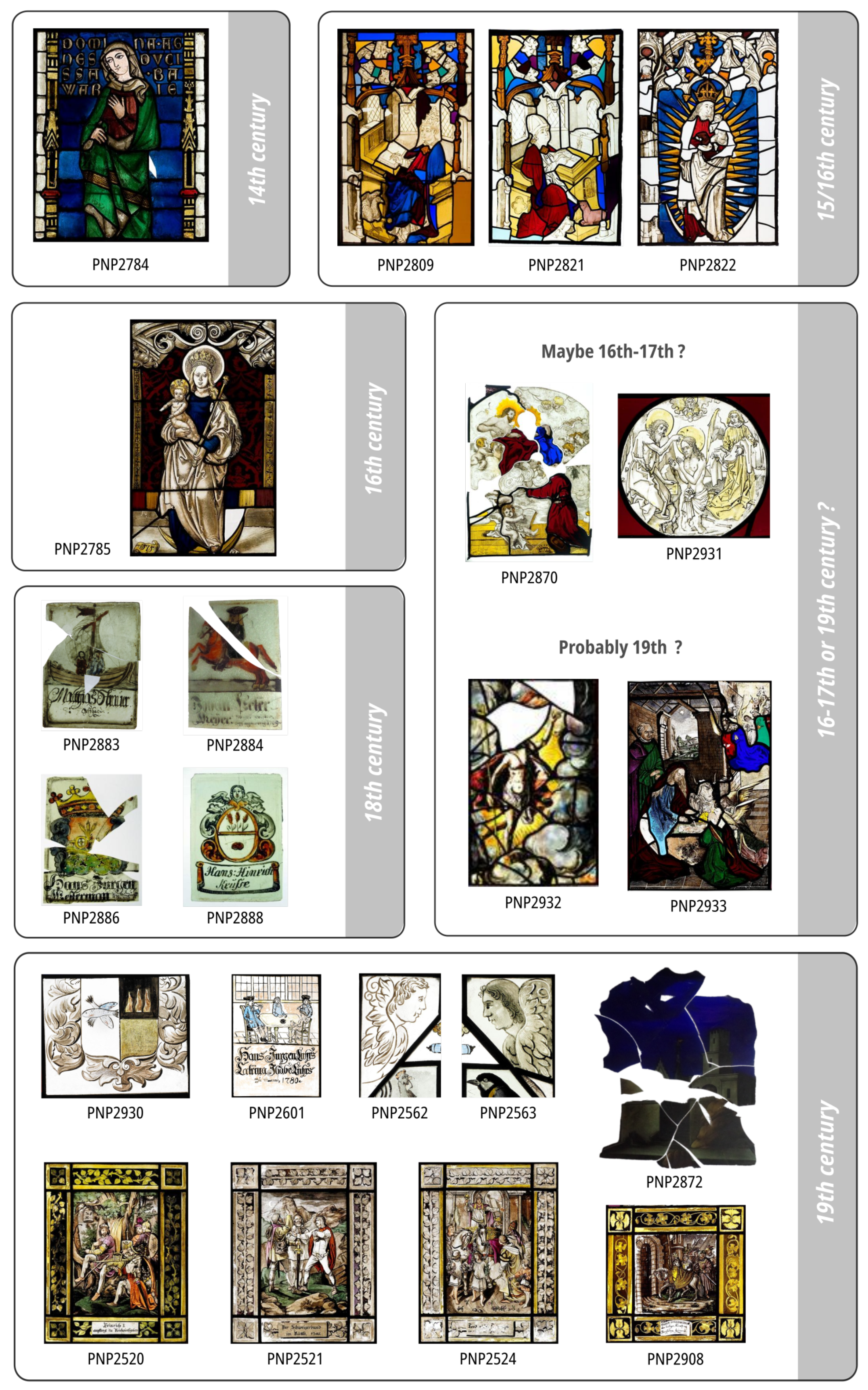
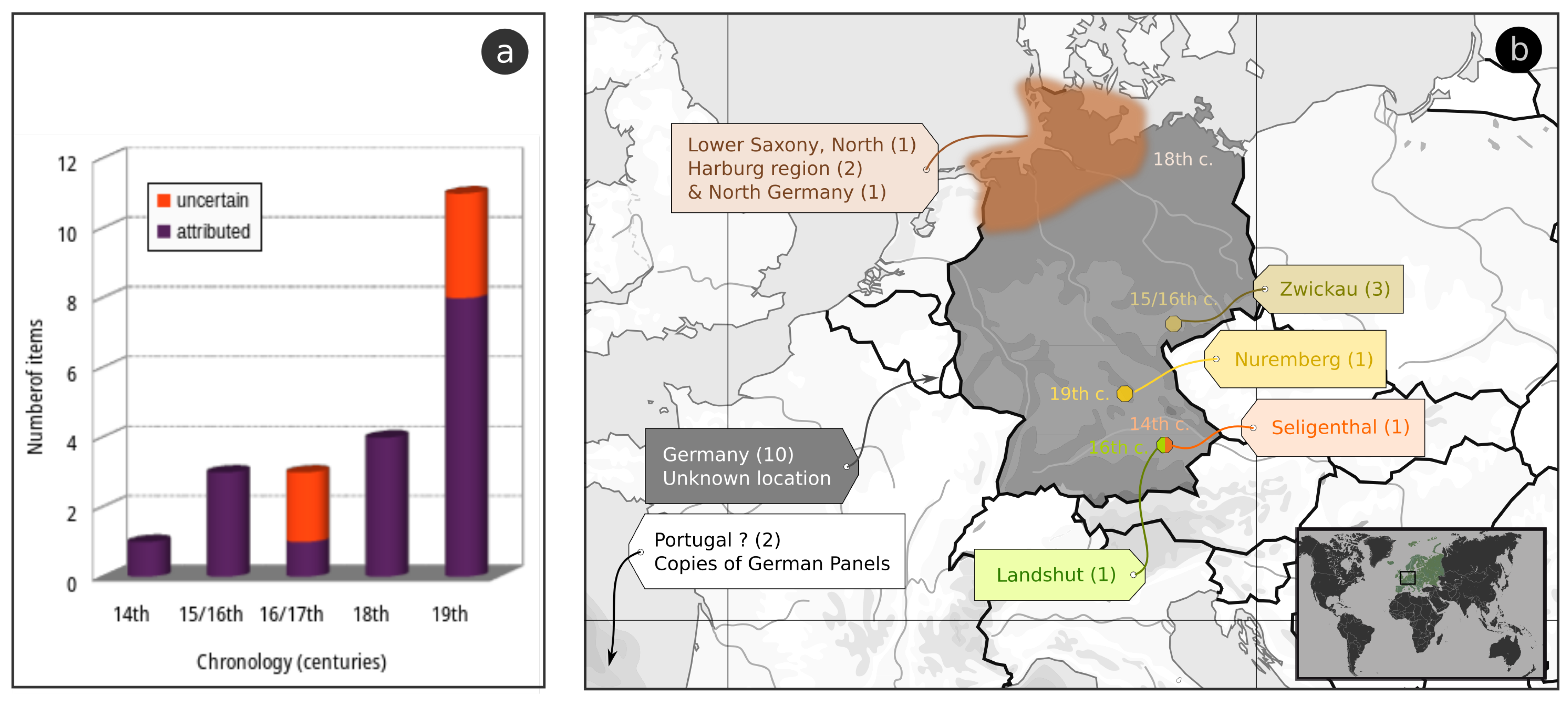
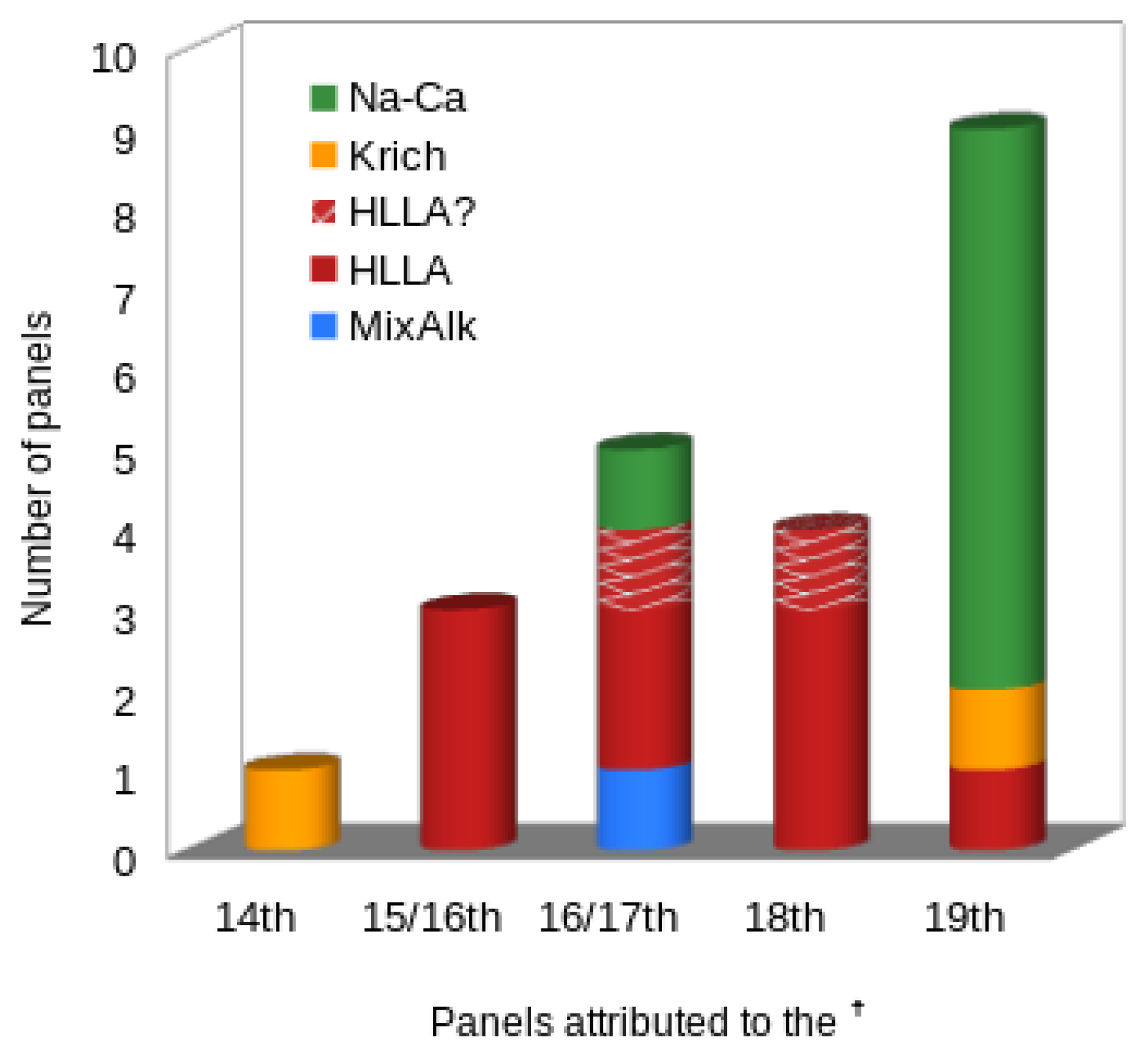
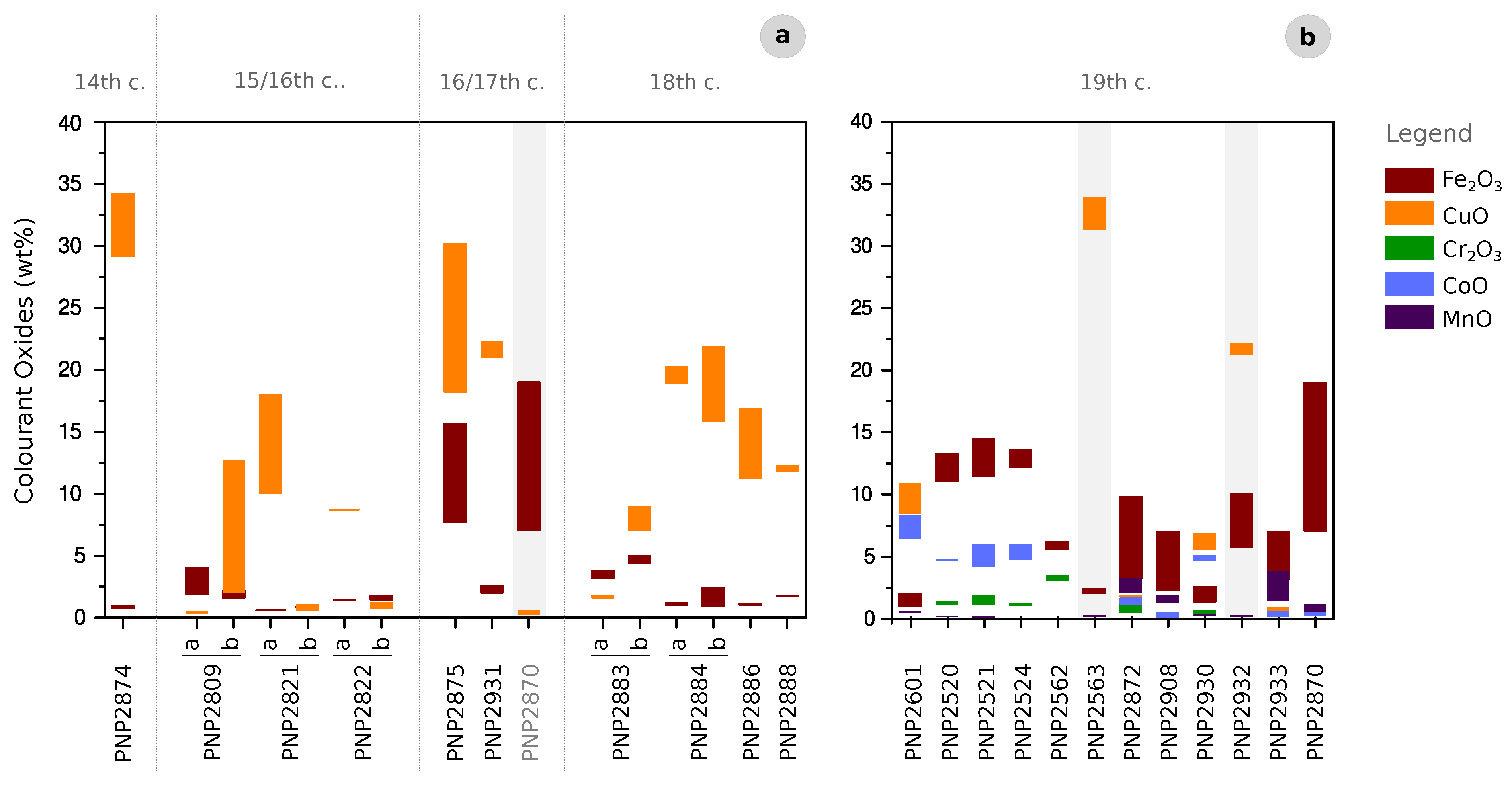

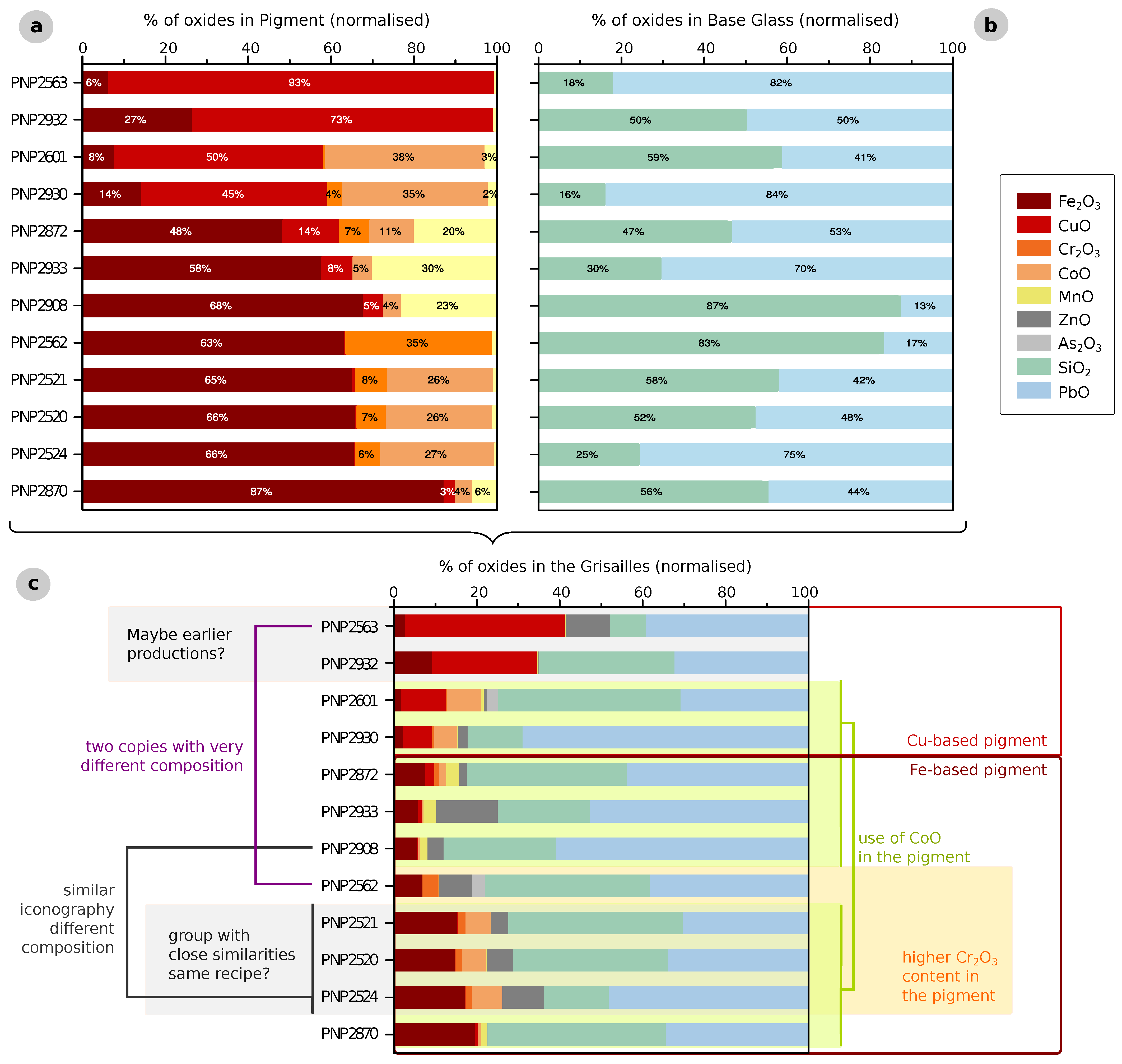

| Chronology | Inv. Nr. | Pigment | Base Glass | ||||||||||
|---|---|---|---|---|---|---|---|---|---|---|---|---|---|
| Cu | Fe | Mn | Zn | Co | Ni | As | Cr | Pb | Si | Zn | |||
| 14th | PNP2784 | • | • | • | • | ||||||||
| 15/16th | PNP2809 | (a) | • | • | • | • | |||||||
| (b) | • | • | • | • | |||||||||
| PNP2821 | (a) | • | • | • | • | ||||||||
| (b) | • | • | • | • | |||||||||
| PNP2822 | (a) | • | • | • | • | ||||||||
| (b) | • | • | • | • | |||||||||
| 16/17th | PNP2785 | • | • | • | • | ||||||||
| PNP2870 | • | • | • | • | • | • | • | ||||||
| PNP2931 | • | • | • | • | • | ||||||||
| 18th | PNP2883 | (a) | • | • | • | • | |||||||
| (b) | • | • | • | • | |||||||||
| PNP2884 | • | • | • | • | |||||||||
| PNP2886 | • | • | • | • | |||||||||
| PNP2888 | • | • | • | • | |||||||||
| 19th | PNP2601 | • | • | • | • | • | • | • | • | • | |||
| PNP2520 | • | • | • | • | • | • | • | • | |||||
| PNP2521 | • | • | • | • | • | • | • | • | |||||
| PNP2524 | • | • | • | • | • | • | • | • | • | • | |||
| PNP2562 | • | • | • | • | • | • | • | • | |||||
| PNP2563 | • | • | • | • | • | • | |||||||
| PNP2872 | • | • | • | • | • | • | • | • | • | • | |||
| PNP2908 | • | • | • | • | • | • | • | • | • | ||||
| PNP2930 | • | • | • | • | • | • | • | • | • | ||||
| PNP2932 | • | • | • | • | |||||||||
| PNP2933 | • | • | • | • | • | • | • | • | |||||
Publisher’s Note: MDPI stays neutral with regard to jurisdictional claims in published maps and institutional affiliations. |
© 2022 by the authors. Licensee MDPI, Basel, Switzerland. This article is an open access article distributed under the terms and conditions of the Creative Commons Attribution (CC BY) license (https://creativecommons.org/licenses/by/4.0/).
Share and Cite
Rodrigues, A.; Coutinho, M.L.; Machado, C.; Cerqueira Alves, L.; Machado, A.; Vilarigues, M. An Overview of Germanic Grisailles through the Stained-Glass Collection at Pena Palace. Heritage 2022, 5, 1003-1023. https://doi.org/10.3390/heritage5020055
Rodrigues A, Coutinho ML, Machado C, Cerqueira Alves L, Machado A, Vilarigues M. An Overview of Germanic Grisailles through the Stained-Glass Collection at Pena Palace. Heritage. 2022; 5(2):1003-1023. https://doi.org/10.3390/heritage5020055
Chicago/Turabian StyleRodrigues, Alexandra, Mathilda L. Coutinho, Carla Machado, Luís Cerqueira Alves, Andreia Machado, and Márcia Vilarigues. 2022. "An Overview of Germanic Grisailles through the Stained-Glass Collection at Pena Palace" Heritage 5, no. 2: 1003-1023. https://doi.org/10.3390/heritage5020055
APA StyleRodrigues, A., Coutinho, M. L., Machado, C., Cerqueira Alves, L., Machado, A., & Vilarigues, M. (2022). An Overview of Germanic Grisailles through the Stained-Glass Collection at Pena Palace. Heritage, 5(2), 1003-1023. https://doi.org/10.3390/heritage5020055






